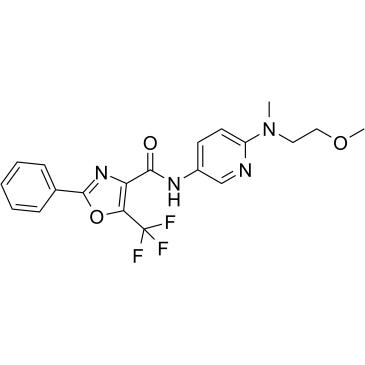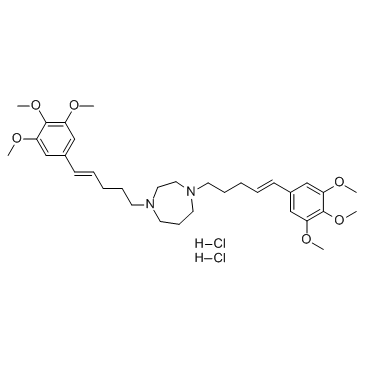 To enhance service speed and avoid tariff delays, we've opened a US warehouse. All US orders ship directly from our US facility.
To enhance service speed and avoid tariff delays, we've opened a US warehouse. All US orders ship directly from our US facility.
| Cat. No. | Product Name | Field of Application | Chemical Structure |
|---|---|---|---|
| DC39251 | WKYMVm Featured |
WKYMVm is a selective agonist for the formyl peptide receptors FPR1, FPR2 (EC50 = 75 pM) and FPR3 (EC50 = 3 nM), expressed on immune cells. Induces Ca2+ mobilization and superoxide production in, and chemotaxic migration of, monocytes and neutrophils. Also promotes monocyte survival through a PKC-, PI 3-kinase- and Akt-dependent pathway.
More description
|

|
| DC39254 | DGAT1-IN-3 Featured |
DGAT1-IN-3 is a potent, selective and orally bioavailable inhibitor of DGAT-1, with IC50s of 38 nM for human DGAT-1 and 120 nM for rat DGAT-1. DGAT1-IN-3 could be used to research of obesity, dyslipidemia, and metabolic syndrome[1][2].
More description
|

|
| DC23943 | K-7174 dihydrochloride Featured |
K-7174 dihydrochloride is a selctive small molecule inhibitor of the transcription factor GATA-binding protein 2 (GATA2).
More description
|

|
| DC11225 | sabizabulin(VERU-111) Featured |
VERU-111 (Sabizabulin) is a novel potent colchicine binding site inhibitor (CBSI) in tubulin with potential anticancer activities. Sabizabulin is a novel oral agent with both anti-viral and anti-inflammatory activities.Sabizabulin is a cytoskeleton disruptor which by causing microtubule depolymerization has both anti-viral and anti-inflammatory activity and could be effective against the SARS-CoV-2 virus by disrupting its intracellular transport along the microtubules. Microtubule trafficking is critical for viruses to be transported, replicated, assembled, and released from the cell. In addition, microtubule depolymerization drugs that target the “colchicine binding site” of microtubules, like sabizabulin, also have strong anti-inflammatory effects, including the potential to treat the cytokine release syndrome (cytokine storm) and septic shock induced by the SARS-CoV-2 viral infection that is associated with high COVID-19 mortality rates.
More description
|

|
| DC10217 | TRx0237 (LMTX) mesylate Featured |
TRx 0237 (LMTX™) mesylate is a second-generation tau protein aggregation inhibitor for the treatment of Alzheimer's disease (AD) and frontotemporal dementia.
More description
|

|
| DC11857 | BAY-8040 (R) Featured |
Bay-8040 is a potent, selective human neutrophil elastase (HNE) inhibitor with IC50 of 28 nM; displays no significant inhibition toward 68 other pharmacologically relevant targets (>10 uM), and a panel of related serine proteases; shows in vivo efficacy with regard to decreasing cardiac remodeling and amelioration of cardiac function in monocrotaline-induced rat model for pulmonary arterial hypertension.
More description
|

|
| DC28774 | CB-103 Featured |
CB-103 is a notch signaling pathway inhibitor extracted from patent US9296682B2. CB-103 is developed for the treatment of cancers.
More description
|

|
| DC49409 | Glucose oxidase |
Glucose oxidase is used in the food and beverage industry as a preservative and stabilizer and is commonly derived from the fungus Aspergillus niger. Glucose oxidase can react with intracellular glucose and oxygen (O2) to produce hydrogen peroxide (H2O2) and gluconic acid, which can cut off the nutrition source of cancer cells and consequently inhibit their proliferation.
More description
|

|
| DC49407 | Serratia marcescens nuclease |
Serratia marcescens nuclease is a nonspecific nuclease. Serratia marcescens nuclease has broad utility due to its potent digestive activity toward both DNA and RNA.
More description
|

|
| DC49406 | Calcium alginate |
Calcium alginate is a biopolymer that can be used for developing oral drug-delivery systems. Calcium alginate is a pH sensitive hydrogel stable in acidic media and soluble in basic media.
More description
|

|
| DC49405 | Beta-glucuronidase |
Beta-glucuronidase is an important lysosomal enzyme involved in the degradation of glucuronate-containing glycosaminoglycan.
More description
|

|
| DC49404 | λ-Carrageenan |
λ-Carrageenan is a seaweed polysaccharide which has been generally used as proinflammatory agent in the basic research. λ-Carrageenan is a potent antitumor agent.
More description
|

|
| DC49403 | β-D-Glucan |
β-D-glucan is a natural non-digestible polysaccharide and high biocompatibility that can be selectively recognized by recognition receptors such as Dectin-1 and Toll-like receptors as well as being easily internalized by murine or human macrophages, which is likely to attribute to a target delivery. β-d-glucan is an enteric delivery vehicle for probiotics.
More description
|

|
| DC49402 | Sodium phosphate monobasic monohydrate |
Sodium phosphate monobasic monohydrate is a commonly used buffer.
More description
|

|
| DC49401 | DMNB |
DMNB (6-Nitroveratraldehyde), a precursor, can be used for the synthesis no-carrier-added 6-[18F]fluoro-L-DOPA (6-FDOPA). No-Carrier-Added (NCA) 6-[18F]fluoro-L-dopa (6-FDOPA) is being produced routinely for PET investigations of dopaminergic systems.
More description
|

|
| DC49400 | Salicylamide-O-acetic acid |
Salicylamide-O-acetic acid is a theophylline solubilizer.
More description
|

|
| DC49399 | 3,5-Dibromotyrosine |
3,5-Dibromotyrosine is a product of protein oxidation by eosinophil peroxidase.
More description
|

|
| DC49398 | Hippuric acid-15N |
Hippuric acid-15N (2-Benzamidoacetic acid-15N) is the 15N-labeled Hippuric acid. Hippuric Acid (2-Benzamidoacetic acid), an acyl glycine produced by the conjugation of benzoic acid and glycine, is a normal component in urine as a metabolite of aromatic compounds from food.
More description
|

|
| DC49397 | Epicoccone B |
Epicoccone B, firstly reported from C. globosum, exhibits the DPPH free radical scavenging ability with IC50 value of 10.8 μM, and has potent α-glucosidase inhibition with IC50 value of 27.3 μM. Anti-HIV activity.
More description
|

|
| DC49396 | Flavipin |
Flavipin is an aryl hydrocarbon receptor (Ahr) agonist that induces the expression of Ahr downstream genes in mouse CD4+ T cells and CD11b+ macrophages. Flavipin inhibits the stabilizing function of Arid5a on Il23a 3′UTR, a newly identified target mRNA. Flavipin exhibits the DPPH free radical scavenging ability with IC50 value of 7.2 μM, and has potent α-glucosidase inhibition with IC50 value of 33.8 μM.
More description
|

|
| DC49395 | Phenosulfazole |
Phenosulfazole is an effective antiviral agent. Phenosulfazole has the potential for the research of poliomyelitis virus.
More description
|

|
| DC49394 | 5-Amino-8-hydroxyquinoline |
5-Amino-8-hydroxyquinoline (5A8HQ), a potential anticancer candidate, has promising proteasome inhibitory activity.
More description
|

|
| DC49393 | 3,5,7-Trihydroxychromone |
3,5,7-Trihydroxychromone is the analogue of galangin. 3,5,7-Trihydroxychromone is also the binder of bovine serum albumin. 3,5,7-Trihydroxychromone undergoes multiple antioxidant pathways.
More description
|

|
| DC49392 | (±)-Muscarine chloride |
(±)-Muscarine chloride is the racemate of Muscarine chloride. Muscarine is a prototype muscarinic acetylcholine receptor agonist.
More description
|

|
| DC49391 | D-Isofloridoside |
D-Isofloridoside, one of the polysaccharide precursors, has the activity of scavenging free radicals, inhibiting ROS expression, and inhibiting MMP-2 and MMP-9.
More description
|

|
| DC49390 | PLGA-PEG-NH2 |
PLGA-PEG-NH2 is a material to synthesis nanomicelles. PLGA-PEG-NH2 nanomicelle is an efficient delivery system of Irinotecan for targeted colorectal cancer and hepatocellular carcinoma.
More description
|

|
| DC49389 | α-HNJNAc |
α-HNJNAc is a potent, competitive hexosaminidases inhibitor without interfering with other glycosidases.
More description
|

|
| DC49388 | H-Glu-OtBu |
H-Glu-OtBu is a non-cleavable ADC linker used in the synthesis of antibody-drug conjugates (ADCs). H-Glu-OtBu is also a alkyl chain-based PROTAC linker that can be used in the synthesis of PROTACs[2
More description
|

|
| DC49387 | 1-Boc-azetidine-3-yl-methanol |
1-Boc-azetidine-3-yl-methanol is a non-cleavable ADC linker used in the synthesis of antibody-drug conjugates (ADCs). 1-Boc-azetidine-3-yl-methanol is also a alkyl chain-based PROTAC linker that can be used in the synthesis of PROTACs[1]
More description
|

|
| DC49386 | 2-Amino-8-oxononanoic acid |
2-Amino-8-oxononanoic acid is an amino acid, incorporation into proteins in E.coli in genetic. 2-Amino-8-oxononanoic acid is efficient in labeling of proteins with different probes with a site-specific manner under a mild condition close to the physiological pH.
More description
|

|